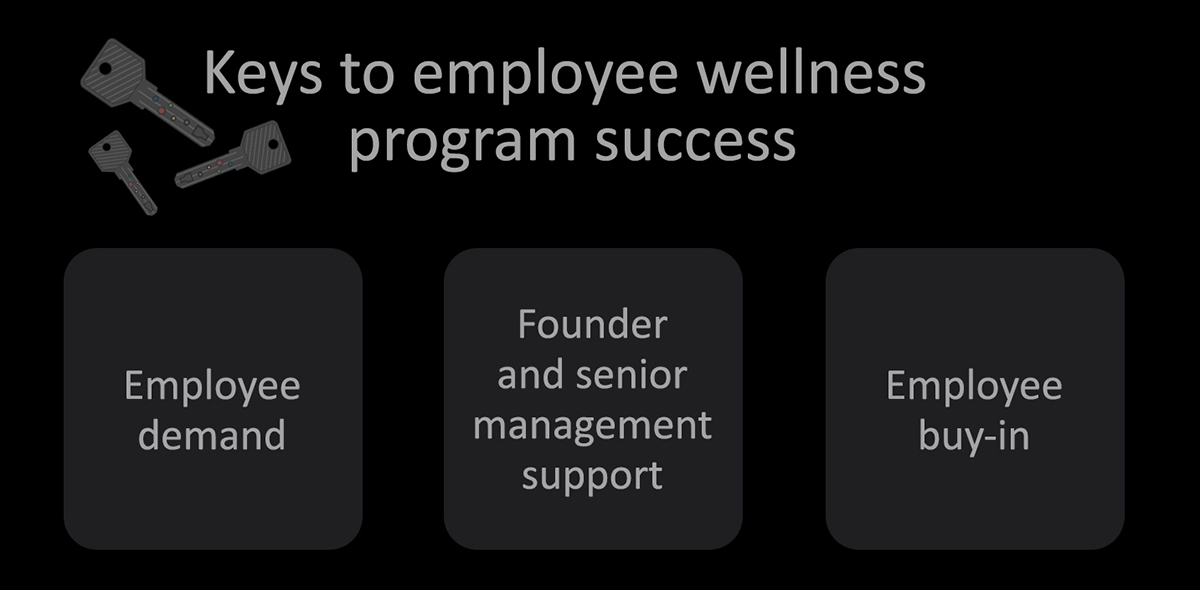In high-growth companies, usually venture-funded startups, the stresses of work can seem even more acute. Even in companies that have grown organically and continue to grow at a quicker pace than competitors, everyone can be under enormous pressure to keep performing at their best.
Both employees and employers are starting to realize and accept that fact that a 24/7 approach to work is not healthy. Putting too much pressure on people reduces productivity. CareerBuilder’s survey identified that 61% of employees are burned out on their current job.
Over worked employees are absent more due to sickness, or even being present while being mentally checked-out, make more mistakes, and when people are under too much pressure for too long they start to look elsewhere for work.
Benefits of Employee Wellness Programs
Business benefits
- Healthier, happier, more productive employees
- Reduced sickness and absenteeism
- Improved ability to retain your greatest assets: your team
- Higher productivity
- Give your employees much-needed perks (walk the walk on mental health)
- Give your company a competitive edge when it comes to recruitment
Team benefits
- Reduce stress
- Improve mental health
- Improved physical heath and diet
- Improve personal financial wellness
- Enjoy work more
Businesses that implement wellness programs earn back a financial and cultural benefit, and employees are happier, more productive and stay for longer. Retaining talent improves competitiveness and makes it somewhat easier for high-growth companies to hit the kind of targets they are aiming for.
How to Implement Employee Wellness?
An employee wellness program can come in many forms.
It can either be a program directed from the top-down, with an external provider or vendor. Or it can come from employee suggestions and those being implemented holistically throughout the organization, sometimes using external providers where experts and professionals are needed.
For example, staff at the Health Innovation Network are told to disengage from email at no later than 7pm. In an FT article, Tara Donnelly, CEO, said:
We want to make sure people switch off, so we have a curfew for recharging. You need to be with your family and have a digital detox.
Policies such as this are increasingly common in companies that are all too aware of the negative impact of too much hyper-connectivity. Many employers – from large organizations like Johnson & Johnson to small ones like Wellness International (a young company providing health and wellness services) – are offering their employees access to online health apps, gym membership, weekly massages and treadmill desks.
Some of these health and wellbeing initiatives have been driven by employee suggestions, others by company culture and strategy.

To make an employee wellness program a success, there needs to be a confluence of factors:
1. Employee demand. This is increasingly clear and slowly becoming a must-have in most workplaces;
2. Founder and senior management support. Owners and managers are responding to employee demand, making this something that more companies are investing in;
3. Employee buy-in. Supply doesn’t always create more demand. Employees who want these programs will engage; the challenge is getting those who aren’t engaged to get on-board, as they’re often the employees who need fitness and mental health support even more than those already committed to the idea.
Wellness, fitness, mental health and even personal financial support and programs are widely available from a number of providers. Companies are increasingly supportive of the idea. Employees and even freelancers are keen to work with businesses that provide this sort of perks. As more companies adopt them, others will follow, otherwise they risk losing talented staff to those who are already ahead of the game.


